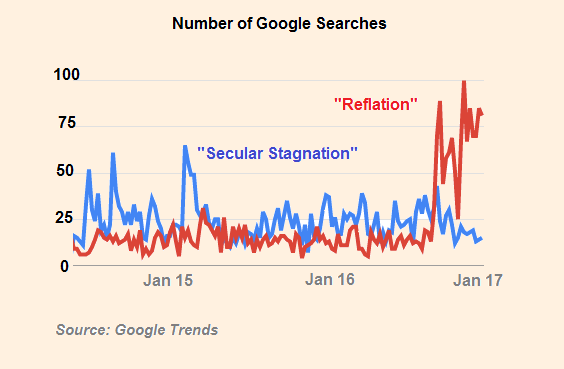From Gavyn Davies' blog at the Financial Times:
A year ago, Lawrence Summers’ perceptive warnings
about the possibility of secular stagnation in the world economy were
dominating global markets. China, Japan and the Eurozone were in
deflation, and the US was being dragged into the mess by the rising
dollar. Global recession risks were elevated, and commodity prices
continued to fall. Fixed investment had slumped. Productivity growth and
demographic growth looked to be increasingly anemic everywhere.
Estimates of the equilibrium real interest rate in many economies were
being marked down. It seemed possible that the world economy would fall
into a “Japanese trap”, in which nominal interest rates would be
permanently stuck at the zero lower bound, and would therefore not be
able to fall enough to stimulate economic activity.

Just when the sky seemed to be at its darkest, the outlook suddenly
began to improve. Global reflation replaced secular stagnation as the
theme that dominated investor psychology, especially after Donald
Trump’s election in November. Why has secular stagnation lost its mass
appeal, and has it disappeared forever? Was it all a case of crying
wolf?
Lawrence Summers has always made it clear that in his mind secular
stagnation was a hypothesis, not a proven reality, especially in the US.
He and others have argued that the combination of very low global GDP
growth, alongside falling real interest rates, could be caused by two
factors: (i) inadequate global demand, stemming from low business
investment, high savings rates in Asia, wide disparity in income
distribution and rising risk aversion; and (ii) inadequate global
supply, stemming from falling productivity growth, and slowing growth in
the labour force....MORE
